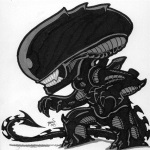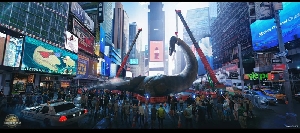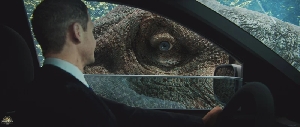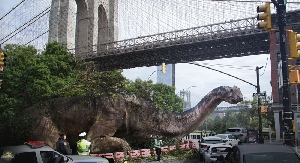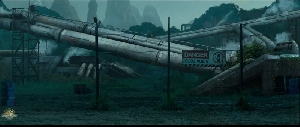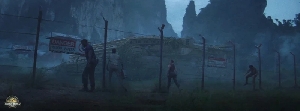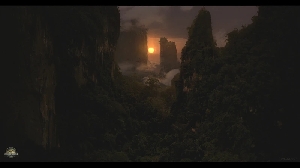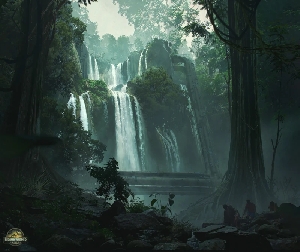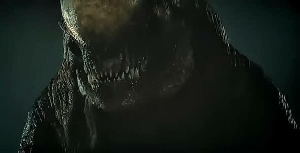Life: A 540 Million Year Journey Parts 4-5
Dinosaurs Forum Topic

I Meme Everything
MemberAllosaurusNov 3, 20186966 Views3 RepliesPart Four: Early Permian, 290 MYA
The Carboniferous Rainforest Collapse has signalled the dawn of the Permian Period. The global climate is slowly becoming more arid. In Texas, one of the last remnants of the preceding period remains: a swamp, that will soon see its end.
A herd of Edaphosaurus bask in the sunlight. These creatures may look like reptiles, but they're actually more closely related to us. These quadrupedal synapsids possess a magnificent sail on their back that helps monitor their body temperature. However, they're not the only sail-backs around.
As the herd was gathered around a lake, drinking and feeding, an ominous smell filled their nostrils. The scent of fear. Dread began to fill their brains as something charged at one of them: another sail-back! Only this one was a carnivore, a predator.
The injured Edaphosaurus shrieks in pain as razor-sharp teeth impale his leathery hide. The attacker isn't another Edaphosaurus; his kind are peaceful herbivores. The carnivore is a Dimetrodon; the most famous animal of the Paleozoic Era. The wounded Edaphosaurus lags behind the fleeing herd as blood drips from a gash in his side. The carnivore follows as the herbivore collapses. He is quickly finished off by the fearsome fangs of the Dimetrodon.
Dimetrodon is not a dinosaur. Like Edaphosaurus, he's a synapsid; more closely related to mammals. He's our most unlikely ancestor. The predator rips into the carcass, pulling out chunks of flesh with every bite. The synapsid then rests near the water's edge. He's named Apollo, after the Greek God of the Sun. When he's not hunting or eating, Apollo spends most of the day relaxing. This has been his territory for his entire life. However, his home will soon be gone, as the wet swamps are slowly replaced with dry deserts.
The Edaphosaurus are the ones who suffer the most from the loss of their swampland home. Their primary source of food will be cut off, leaving them with nothing to eat. Without any Edaphosaurus to hunt, Apollo will eventually starve.
***
Weeks pass, and the swamps begin to dry up. Now, it's only a few scattered water holes dotted with vegetation. The herd's population is dropping, reduced to twelve individuals. Apollo feasts on the corpses of one of the herd’s dead. With the herd slowly dying off, he's thriving...for now.
*Two weeks later*
The swamp was reduced to one last water hole and the surrounding plant life. The herd was no more than a quartet, the sands of the surrounding desert burying their fallen herd-mates. Apollo realized that his primary food source was disappearing before his eyes. Still, he feasted on the body of the herd's most recent casualty.
The Edaphosaurus were spelling their own doom. Within a few days, they've drunk the watering hole dry and stripped what's left of the vegetation. Apollo watched the four herbivores as they looked around for food. They had nowhere to go and refused to leave their home. One of them moaned before falling over, dead from starvation. The remaining three mourned as Apollo took advantage of the opportunity and began to devour the corpse.
*Two weeks later*
Two weeks pass, and the last of the herd passes away, condemning both Edaphosaurus and Dimetrodon to extinction. As we enter the final desperate years of the Paleozoic, we will meet even stranger creatures who are still related to us, including one of the most successful species that has ever evolved. We will also see life's greatest test at the end of the Permian: the Great Dying.
Part Five: Late Permian, 252 MYA
All the continents on Earth have united, creating a single landmass called Pangaea. A mountain range divides its northern and southern regions, both of which contain vast deserts. Natural selection is especially precise, where animals have to be the equivalent of Olympian athletes. Only the strongest will survive, especially with the storm that is coming.
Deserts exist even in Siberia, in one of the most north regions of the supercontinent. Here, the toughest animals of the time exist. There’s Scutosaurus, a relative of turtles, Lystrosaurus, one of the most successful species of all time, and Thrinaxodon, one of our distant ancestors. A herd of Scutosaurus feeds on the desert’s sparse vegetation in the desert heat. They’re unaware that they are being watched. One sniffs the air and looks around, seeing movement behind one of the sand dunes. He snorted to his herd, telling them that they have company.
The one who had spotted movement was unaware that it was now behind him. By the time he realized that something was behind him, it was too late. A predator leaped up and grabbed him by the neck, sending him to the ground. The attacker is an Inostrancevia: Pangaea’s apex predator. He finishes off the wounded Scutosaurus with a bite to the throat. His jaws have a lethal weapon: one of the world’s first pair of saber teeth. Although he’s not a true mammal, a certain Cenozoic mammal will also use saber teeth.
He began to rip into his kill, but he wouldn’t have the time to enjoy it. The ground began to rumble as lava churned beneath the Earth’s crust. It erupted from the ground in a massive explosion from a volcanic region known as the Siberian Traps. Magma has been building up for an extraordinarily long time, finally coming to the surface. It’s hard to believe, but this volcanic region will extinguish ninety-five percent of life on the planet.
The initial eruptions will kill unfathomable numbers of animals in a storm of fire and lava, but the eruptions will continue for hundreds of thousands of years, setting in motion events that will kill most life on the planet. Not only does the magma burn everything it touches, but it releases excessive amounts of carbon dioxide and methane into the atmosphere. These greenhouse gases will superheat the planet, turning Siberia into the Sahara as well as the rest of the planet.
The global warming will usher in the highest temperatures life has ever known, making it extremely difficult to survive and turning the air foul. Methane will combine with other gases to cause acid rain, which will eat the vegetation before the herbivores can. As bad as land has it, the oceans will suffer much more. The waters will reach temperatures exceeding a hundred degrees fahrenheit, causing them to become stagnant and lose oxygen. This will kill off most organisms and allow anaerobic bacteria to survive. These microbes will tint the water pink and pump hydrogen sulfide into the oceans and atmosphere, killing animals everywhere.
***
A hundred thousand years after the first eruptions. Lava still pours from the Siberian Traps, sending biomes into turmoil. In Siberia, a herd of Scutosaurus succumbs to a storm of acid rain, as an Inostrancevia moves in to eat one of the carcasses. Before he can sink his teeth in, however, a wind blows in his direction--carrying hydrogen sulfide. He collapses as the wind circulates the toxic substance to other areas, killing masses of animals miles away.
Many herbivores are starving to death because the acid rain is killing off the vegetation on which they rely for sustenance. Although the carrion will keep carnivores like Inostrancevia going for a little while, they will be without a long-term source of food. They’ll turn on each-other, resorting to cannibalism with no other option.
Near the traps, one Inostrancevia feeds on the carcass of another. Another approaches, desperate for a meal. The two predators snarl at each-other, but before a fight can begin, the ground rumbles. Lava gushes out of a crack in the Earth, separating the two carnivores as they back away from the fissure. Lava flows out, burning the carcass and both Inostrancevia as they howl in agonizing pain.
Despite the high extinction rates, a few species are pulling through. The Lystrosaurus have become toughened and hardened by the hardships caused by the traps, natural selection picking off all but the toughest and hardiest of the genus. They’ve become survivors, designed to pull through the extinction. Thrinaxodon is also trying to survive, both genera facing selection pressure to evolve or die.
*500,000 years after the first eruptions*
After 500,000 years of chaos and tragedy, the Siberian Traps have finally stopped erupting, leaving a planet that is essentially dead in its wake. Only five percent of all life remains, and even then, only the toughest of these survivors carry on. Of these lucky few are the Lystrosaurus, who have migrated south from Siberia. They’ve scoured the land, looking for anything they could find. Thrinaxodon has also survived the Great Dying, and its descendants will give rise to human beings.
Most other animals are not lucky. Even the former master of the Permian world, Inostrancevia, has met its end. Only one individual remains, diseased and famined. Then, he collapses--gone, never to return.
The stem-mammals--which includes both Lystrosaurus and Inostrancevia--have been dealt a crushing blow. Although Lystrosaurus will go on to conquer every continent in the next few million years, after its success, stem-mammals will go into a decline.
However, even the Permian Extinction could not purge all life. Earth will live again, entering a new era: the Mesozoic. From the ashes of the Great Dying, newer, more terrifying forms of life will emerge. Least among them: the dinosaurs.
"Part of the journey is the end..."
Replies to Life: A 540 Million Year Journey Parts 4-5
Hey Guest, want to add your say?
Are you an avid Jurassic World fan looking for a dedicated online community of likeminded fans? Look no further! Create your own profile today and take part in our forums and gain XP points for all the content you post!



